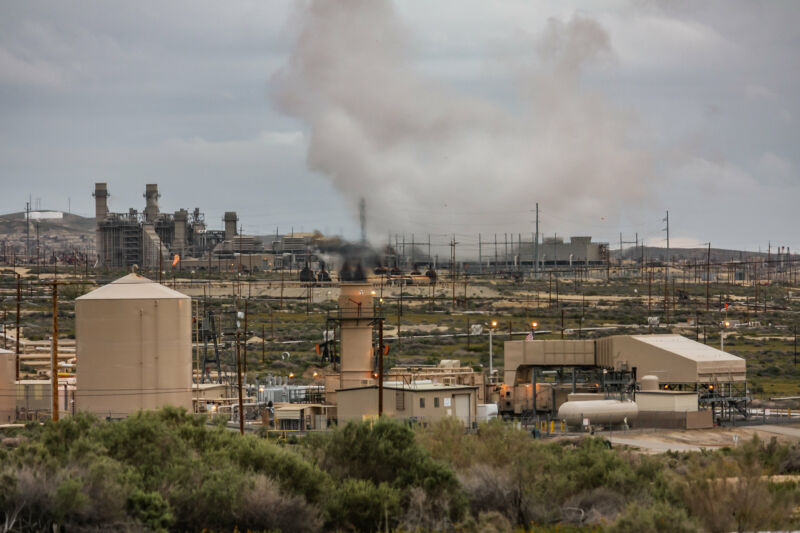
It’s called the “bomb curve”—a drastic spike in the amount of radioactive (but harmless) carbon-14 in the atmosphere, ushered in by the nuclear age. Scientists can sometimes utilize it as a marker in time when it’s captured by something like tree rings, for example. But the bomb curve can also obscure answers by muddying the waters. That includes the question of just how much methane emissions human activities have released.
The bomb curve
Different sources of methane emissions, ranging from plant decay in wetlands to bubbling seeps around mud volcanoes, come with different signatures of carbon isotopes. Geological sources of methane are quite old, giving any carbon-14 plenty of time to radioactively decay and disappear. Carbon in methane from recently alive plant material, on the other hand, will still have about the same amount of carbon-14 we find in the atmosphere (where it is continually produced).
So if the share of carbon-14-bearing methane in the atmosphere were to decrease, you could determine that “old carbon” methane emissions were increasing. The “bomb curve” ruins that trick by introducing a new variable that has nothing to do with categories of methane emissions. And that has made it harder for researchers to figure out how certain natural sources of methane compare to human-caused emissions. We know how much is going into the atmosphere, but we don’t quite know exactly how much of it is our fault.
To address this problem, a group of researchers led by Benjamin Hmiel at the University of Rochester went after samples of air that pre-date the bomb curve. Without a time machine to hop into, they opted for the next best thing: air bubbles in ice cores.
The cores came from Greenland and Antarctica, but the operation was different from most ice cores you read about. Generally, a hockey puck slice of core is plenty to get a data point for the atmospheric gas and temperature records these cores are prized for. But measuring carbon-14 accurately requires a much, much bigger sample—a metric ton per data point, apparently. That means multiple larger-diameter cores and a lower time resolution record.
Changing methane
The results, which span about 1750 to 2013, still manage to clearly show the effects of the Industrial Revolution and the nuclear age. Starting in the late 1800s, carbon-14 became progressively less common in atmospheric methane as human exploitation of fossil fuels released methane devoid of fresh carbon. But this trend reverses in the mid-1900s due to the testing and use of nuclear weapons and, later, nuclear power plants that emit carbon-14.
-
Ice core carbon-14 measurements shown with colored dots. The blue line shows the "bomb curve" of carbon-14 in the nuclear age.Hmiel et al/Nature
-
The increasing concentration of methane in the atmosphere since 1750.Hmiel et al/Nature
The most interesting part of the record is the earliest portion, though. The carbon-14 signature of methane then leaves little room for an old carbon contribution. The researchers put emissions from geological sources at about 1.6 million tons per year, with a maximum of 5.4 million tons. That’s an incredibly small number, given that our best estimates of current geological sources come in around 40-60 million tons per year.
Normally, emissions estimates like these are done with both “top-down” and “bottom-up” methods. You can start at the bottom, measuring individual sites and extrapolating to the globe, or start at the top, measuring changes in the atmosphere and back-calculating contributions from different categories. That gives you a sort of independent check on the numbers. But because of the bomb curve, a top-down check was not possible in this case, and scientists had to extrapolate from a few bottom-up measurements. That includes sources like seafloor seeps (which may or may not reach the atmosphere)—not the easiest thing to comprehensively catalog.
Estimation issues
Assuming that natural geological emissions haven’t changed radically since the 1700s, this implies we’re greatly overestimating them today. That in turn means we're greatly underestimating human-caused emissions of old-carbon methane—by 25-40 percent. Since this old-carbon methane is about a third of the total methane emissions entering the atmosphere, that would make old-carbon methane almost half of all human-caused methane emissions. (The other half comes from things like agriculture and biomass burning.)
While this is a large revision to the numbers, it’s not implausible. The category estimates in the methane emissions ledger have large enough error bars on them that bumping some up and others down could accommodate this revision. And a number of studies measuring emissions from flights over US oil and gas fields have produced estimates greater than the bottom-up EPA estimates for that site. The ice core researchers point to an example of a 60 percent higher estimate from top-down flight data that, if extended to all oil and gas production around the world, would be enough to match this revision.
This doesn’t necessarily mean natural gas power plants are worse for the climate than coal, as some have claimed, but it does imply that our sprawling natural gas infrastructure is causing an even bigger mess than we thought. If you’re an optimist, though, you might say it means we have more opportunity for mitigation. While we can’t stop mud volcanoes, we can certainly fix our leaky pipelines.
Nature, 2020. DOI: 10.1038/s41586-020-1991-8 (About DOIs).
Bagikan Berita Ini














0 Response to "Human activities responsible for more methane emissions than thought - Ars Technica"
Post a Comment